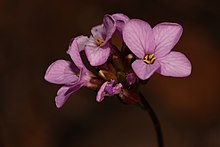
Arabis aculeolata

| Arabis aculeolata | |
|---|---|

| |
| Scientific classification | |
| Kingdom: | Plantae |
| Clade: | Tracheophytes |
| Clade: | Angiosperms |
| Clade: | Eudicots |
| Clade: | Rosids |
| Order: | Brassicales |
| Family: | Brassicaceae |
| Genus: | Arabis |
| Species: | A. aculeolata
|
| Binomial name | |
| Arabis aculeolata | |
Arabis aculeolata is a species of flowering plant in the mustard family known by the common name Waldo rockcress.

Description
This is a perennial herb growing from a tough caudex covered in large hairs and the bases of leaves shed in previous seasons. It produces one or more erect stems to heights between 20 and 35 centimeters. The stems are dark in color, often reddish or purplish, and are coated in stiff white hairs. The leaves form a basal rosette about the caudex. They are oval-shaped, green in color and sparsely covered in coarse white hairs, up to 4 centimeters long, and with smooth or wavy edges. Leaves located farther up the stem are smaller. The flowers have dark purple sepals and lighter purple petals. The fruit is a long, thin, erect silique up to 6.5 centimeters long. The bloom period is between the months of April, May and June.[1] The leaves shape is elliptic, oblanceolate, and obovate. The leaf margin is entire. The inflorescence is raceme. The bloom color is pink or purple.[2]

Some plants in the 1940s seem intermediate between Arabis aculeolata and Arabis modesta. However, this has not been confirmed.[3]

Distribution and habitat
It is native to a small range in the mountains of southern Oregon, where it is an uncommon member of the serpentine soils flora. It is commonly found in the counties of Del Norte and Siskiyou in California.[1] It is found in the counties of Curry, Josephine, Jackson, and Douglas in Oregon.[4]

It has a global rank of G4, which means apparently secure. It has a S3 rank in Oregon, meaning vulnerable, and a S2 rank in California, meaning endangered. The global status was last reviewed in 1989.[5]

Its communities include, yellow pine forest, red fir forest, lodgepole pine forest, and mixed evergreen forest.[1] It is found in rocky hillsides and serpentine soils. It is found at elevations of 200–1800 meters.[3]

References
- ^ a b c "Arabis aculeolata Calflora". www.calflora.org. Retrieved 2023-08-14.
- ^ "Lady Bird Johnson Wildflower Center – The University of Texas at Austin". www.wildflower.org. Retrieved 2023-08-15.
- ^ a b "OregonFlora". oregonflora.org. Retrieved 2023-08-15.
- ^ "Arabis aculeolata | Waldo Rockcress | Wildflowers of the Pacific Northwest". www.pnwflowers.com. Retrieved 2023-08-15.
- ^ "NatureServe Explorer 2.0". explorer.natureserve.org. Retrieved 2023-08-15.
External links
 Media related to Arabis aculeolata at Wikimedia Commons
Media related to Arabis aculeolata at Wikimedia Commons- Jepson Manual Treatment
- USDA Plants Profile
- Photo gallery
See what we do next...
OR
By submitting your email or phone number, you're giving mschf permission to send you email and/or recurring marketing texts. Data rates may apply. Text stop to cancel, help for help.
Success: You're subscribed now !

